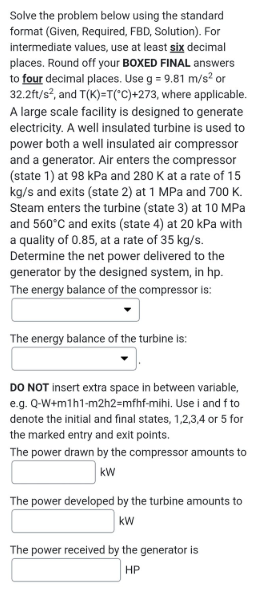The energy balance of the compressor is: The energy balance of the turbine is: DO NOT insert extra space in between variable, e.g. Q-W+m1h1-m2h2=mfhf-mihi. Use i and f to denote the initial and final states, 1,2,3,4 or 5 for the marked entry and exit points. The power drawn by the compressor amounts to kW
The energy balance of the compressor is: The energy balance of the turbine is: DO NOT insert extra space in between variable, e.g. Q-W+m1h1-m2h2=mfhf-mihi. Use i and f to denote the initial and final states, 1,2,3,4 or 5 for the marked entry and exit points. The power drawn by the compressor amounts to kW
Elements Of Electromagnetics
7th Edition
ISBN:9780190698614
Author:Sadiku, Matthew N. O.
Publisher:Sadiku, Matthew N. O.
ChapterMA: Math Assessment
Section: Chapter Questions
Problem 1.1MA
Related questions
Question

Transcribed Image Text:Solve the problem below using the standard
format (Given, Required, FBD, Solution). For
intermediate values, use at least six decimal
places. Round off your BOXED FINAL answers
to four decimal places. Use g = 9.81 m/s? or
32.2ft/s?, and T(K)=T(*C)+273, where applicable.
A large scale facility is designed to generate
electricity. A well insulated turbine is used to
power both a well insulated air compressor
and a generator. Air enters the compressor
(state 1) at 98 kPa and 280 K at a rate of 15
kg/s and exits (state 2) at 1 MPa and 700 K.
Steam enters the turbine (state 3) at 10 MPa
and 560°C and exits (state 4) at 20 kPa with
a quality of 0.85, at a rate of 35 kg/s.
Determine the net power delivered to the
generator by the designed system, in hp.
The energy balance of the compressor is:
The energy balance of the turbine is:
DO NOT insert extra space in between variable,
e.g. Q-W+m1h1-m2h2=mfhf-mihi. Use i and f to
denote the initial and final states, 1,2,3,4 or 5 for
the marked entry and exit points.
The power drawn by the compressor amounts to
|KW
The power developed by the turbine amounts to
kW
The power received by the generator is
НР
Expert Solution
This question has been solved!
Explore an expertly crafted, step-by-step solution for a thorough understanding of key concepts.
Step by step
Solved in 3 steps with 2 images

Knowledge Booster
Learn more about
Need a deep-dive on the concept behind this application? Look no further. Learn more about this topic, mechanical-engineering and related others by exploring similar questions and additional content below.Recommended textbooks for you

Elements Of Electromagnetics
Mechanical Engineering
ISBN:
9780190698614
Author:
Sadiku, Matthew N. O.
Publisher:
Oxford University Press

Mechanics of Materials (10th Edition)
Mechanical Engineering
ISBN:
9780134319650
Author:
Russell C. Hibbeler
Publisher:
PEARSON

Thermodynamics: An Engineering Approach
Mechanical Engineering
ISBN:
9781259822674
Author:
Yunus A. Cengel Dr., Michael A. Boles
Publisher:
McGraw-Hill Education

Elements Of Electromagnetics
Mechanical Engineering
ISBN:
9780190698614
Author:
Sadiku, Matthew N. O.
Publisher:
Oxford University Press

Mechanics of Materials (10th Edition)
Mechanical Engineering
ISBN:
9780134319650
Author:
Russell C. Hibbeler
Publisher:
PEARSON

Thermodynamics: An Engineering Approach
Mechanical Engineering
ISBN:
9781259822674
Author:
Yunus A. Cengel Dr., Michael A. Boles
Publisher:
McGraw-Hill Education

Control Systems Engineering
Mechanical Engineering
ISBN:
9781118170519
Author:
Norman S. Nise
Publisher:
WILEY

Mechanics of Materials (MindTap Course List)
Mechanical Engineering
ISBN:
9781337093347
Author:
Barry J. Goodno, James M. Gere
Publisher:
Cengage Learning

Engineering Mechanics: Statics
Mechanical Engineering
ISBN:
9781118807330
Author:
James L. Meriam, L. G. Kraige, J. N. Bolton
Publisher:
WILEY